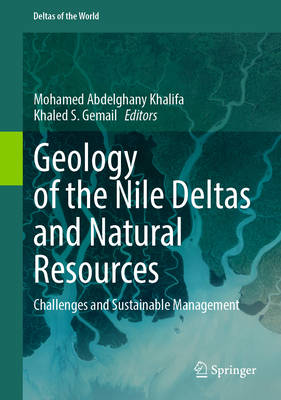
- Afhalen na 1 uur in een winkel met voorraad
- Gratis thuislevering in België vanaf € 30
- Ruim aanbod met 7 miljoen producten
- Afhalen na 1 uur in een winkel met voorraad
- Gratis thuislevering in België vanaf € 30
- Ruim aanbod met 7 miljoen producten
Zoeken
Geology of the Nile Deltas and Natural Resources
Challenges and Sustainable Management
€ 274,95
+ 549 punten
Omschrijving
This book is essential for understanding the Nile Delta, recognized as one of the world's most vulnerable deltas due to population growth and the impacts of sea level rise (SLR). Spanning approximately 38,000 square kilometers, the Nile Delta is the largest delta globally, warranting an in-depth exploration of its geology, hydrocarbon potential, and water resources. This comprehensive volume provides detailed geological insights into both the Recent Nile Delta and the ancient deposits of the El-Fayoum Nile Delta. It highlights the subsurface lithostratigraphic rock units, elucidating possible depositional environments and the distribution and extent of water and hydrocarbon reservoirs. Additionally, the book examines the structural elements that influenced sedimentary rock deposition, supported by well logs and seismic data. For the first time, the book presents critical geological information on both onshore and offshore gas reservoirs, assessing the Nile Delta's hydrocarbon production capacity, organic petrography, and the geochemical characterization of its resources. Employing a multidisciplinary approach that integrates geological, hydrogeological, numerical, and machine learning modeling with geophysical data, this book assesses and monitors the quality and quantity of natural resources for sustainable management in the Nile Delta, Egypt. This book crucially addresses the natural resource challenges posed by climatic changes and anthropogenic stressors, while recommending sustainable practices for development. It aligns with several Sustainable Development Goals (SDGs), including SDG 6: Clean Water and Sanitation, SDG 7: Affordable and Clean Energy, SDG 11: Sustainable Cities and Communities, SDG 13: Climate Action, and SDG 15: Life on Land. This guide is invaluable for a diverse audience, including geologists, hydrologists, researchers, graduate students, stakeholders, policy planners, and decision-makers interested in the Nile Delta's natural resources. It fosters a deeper understanding of the connections between geological processes and resource availability, aiming to support the growing population through the Food-Energy-Water nexus while contributing to global sustainable development goals in arid and semi-arid regions.
Specificaties
Betrokkenen
- Uitgeverij:
Inhoud
- Aantal bladzijden:
- 534
- Taal:
- Engels
- Reeks:
Eigenschappen
- Productcode (EAN):
- 9783031965937
- Verschijningsdatum:
- 2/10/2025
- Uitvoering:
- Hardcover
- Formaat:
- Genaaid
- Afmetingen:
- 168 mm x 231 mm
- Gewicht:
- 1133 g

Alleen bij Standaard Boekhandel
+ 549 punten op je klantenkaart van Standaard Boekhandel
Beoordelingen
We publiceren alleen reviews die voldoen aan de voorwaarden voor reviews. Bekijk onze voorwaarden voor reviews.







